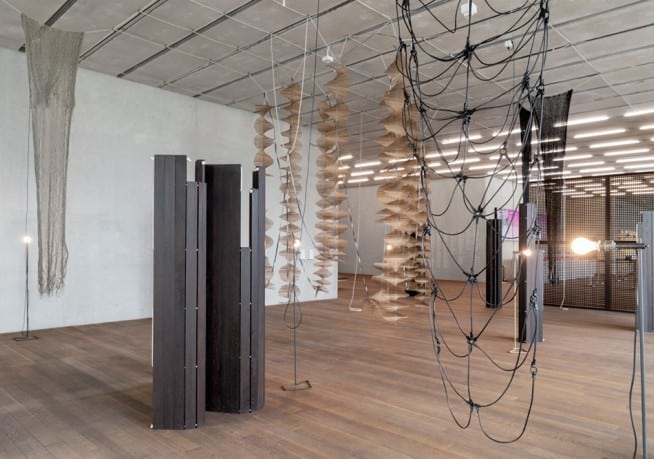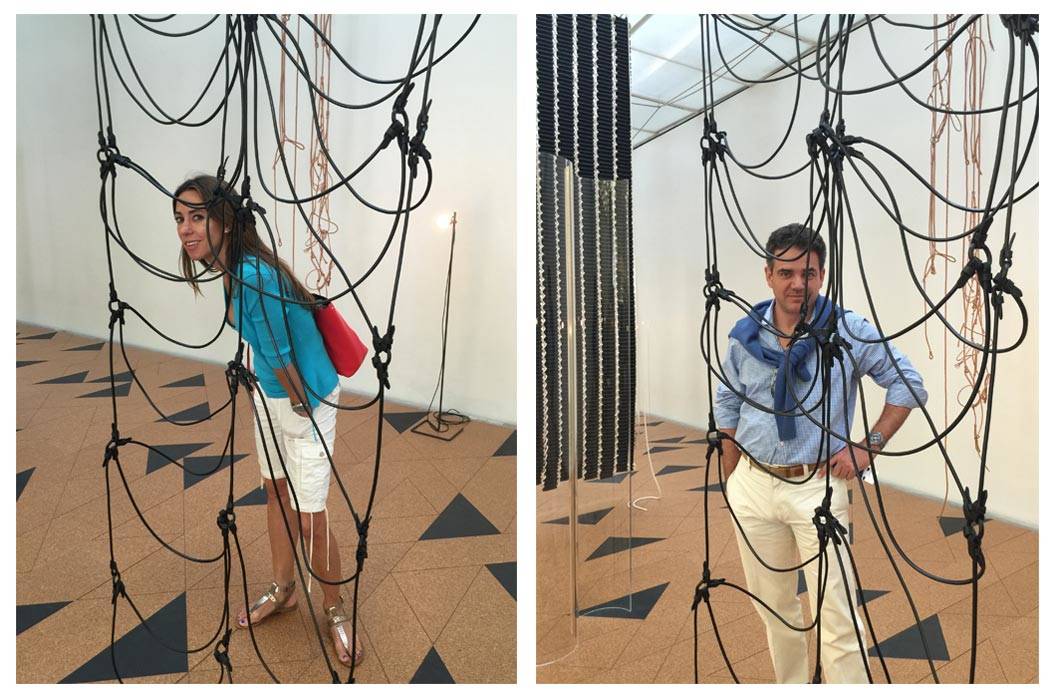Leonor Antunes’ Material Autonomy

A secluded and pleasant land. In this land I wish to dwell,
Installation
Over the years, Antunes’s practice has been resorting more and more to the detailed observation of the exhibition spaces or contexts in which it develops from. Precise measurements and the duplication of existing structures thus become central elements of an artistic strategy that even though traceable back to a minimalist and conceptual heritage depends tremendously on traditional knowledge to be executed.
Antunes’s methodology involves the use of pre-existing elements and objects, which in many but not all cases are of architectural origin. She investigates what occurs when they are duplicated and/or relocated into time and spatial contexts that are foreign to them, and what new feelings and emotions they acquire upon such displacement. Her interest in craft and handwork is present in her use of material such as wood, bamboo, leather, brass, rope, and string. These materials often find sculptural form in her work as vertical or horizontal demarcations in space, or as woven transparent nets and grids. Her work vindicates the material autonomy of forms and also certain autonomy of meaning. Notions such as measure, scale or proportion also play a key role.
Leonor Antunes understands her work as the hybridization of vernacular techniques and the cultural legacy of modernism. This can be seen in Antunes’s selection of materials and their treatment, which are often drawn from craft and handwork traditions, and her reference to the legacy of modernism and its specific geometrical patterns, as well as forms and structures developed by architects and designers of the early twentieth century. Her investigations have included references to the furniture and buildings of the Irish architect Eileen Moray Gray (1878 – 1976) as well as those of the Brazilian Lina Bo Bardi (1914-1992).

Installation view Pérez Art Museum Miami
In recent years, Leonor Antunes’s research-based projects have developed a particular material vocabulary through her recurring use of rope, leather, unusual woods, and brass. The artist places these and other natural materials in dialogue with both international modernist design and architecture from the 1950s and 1960s and indigenous craft traditions from European and non-Western cultural contexts. Involving measurement, repetition, and mirroring, her sculptural installations revisit these sites and forms, imbuing them with subjectivity and a renewed energy that places them in conversation with diverse contemporary art practices.
The title A secluded and pleasant land. In this land I wish to dwell (2014) is derived from a legend related to the creation of the Naikū Ise Shrine, a Shinto shrine dedicated to the goddess Amaterasu-ōmikami in southeastern Japan. The series of wooden buildings that make up this holy site are dismantled and then rebuilt in exactly the same manner every 20 years in a ritual designed to preserve traditional construction techniques and to act as a symbol of impermanence. Through this cyclical recreation, these structures are both continually ancient and renewed. This practice speaks to Antunes’s own interest in repeating the constructions of past forms, and through these recreations, her critique of modernist values related to linear time and originality. The title also references the concept of “dwelling”—inhabiting a space both physically and psychologically through one’s particular bodily proportions and emotional engagement—which deeply informs the artist’s thinking.
Mathematics, measures, scales and the beauty of certain proportions fuel her practice is seen in Adrastus’ Collection artwork: A secluded and pleasant land. In this land I wish to dwell (2014). Her work also enter into a dialogue with the spaces that they occupy, be it through the way they echo the architecture surrounding them, or by her use of its proportions as tools to develop each new installation. For this artwork, Leonor Antunes produced a sculptural-installation, in which she considers the latent performativity of her practice together with the effects of time and space on materials. Several of the installation’s elements relate to research that Antunes has undertaken in Brazil over the last decade. Most recently, the artist’s investigations have involved the work of Brazilian modernist architect João Batista Vilanova Artigas (1915–1985). In 2013, she visited the house he built for his family in São Paulo in 1949 and was able to carefully measure and record the dimensions of its rooms. A screen made from thin tubes of brass, hung in front of the glass walls that enclose this gallery, reproduces the linear pattern and exact measurements of a parquet floor in the main living space of Vilanova Artigas’s home.
The grid plays an important role in Antunes’s practice and she engages the form using several different materials in this work. Her interest in this structure is derived not only from its role in architectural practice, but also its prevalence in the work of several postwar artists. Most directly, her sagging grids, which combine a sense of mathematical order with references to spider webs and nests, recall similar structures used by the Venezuelan artist Gego (Gertrud Goldschmidt, 1912–1994) and the American artist Eva Hesse (1936–1970). Antunes’s grids are also directly related to her interest in preserving and celebrating craft traditions of her native Portugal, particularly handmade fishing nets. She has apprenticed with several older practitioners of this dying craft, learning how to weave these objects by hand. Reflecting these influences, several densely woven nets are hung in this installation, made from hemp rope and black nylon yarn. These are woven without the use of knots, engaging a technique used to produce hammocks that the artist learned from another Brazilian indigenous tribe from the Amazon. Yet another grid, constructed from interlocking horse bridles, also a craft native to Portugal that is nearing extinction, has been produced by the artist in black leather.

Adrastus Collection’s Founders Javier and Lorena Lumbreras at the New Museum, NY.
A secluded and pleasant land. In this land I wish to dwell (2014) has been presented at Kiosk Gallery (2015) in Ghent, Belgium; New Museum (2015), New York, USA; Pérez Art Museum (2015), Miami, USA; 8th Berlin Biennale, KW Institute of Contemporary Art (2014), Berlin, Germany.
Recent solo exhibitions include: PAMM, Pérez Art Museum Miami, U.S.A. (2014); “the last days in Chimalistac”, Kunsthale Basel, Basel, Switzerland (2013); “a linha é tão fina que oolho, apesar de armado com uma lupa, imagina-a ao invés de vê-la”, Kunsthalle Lissabon, Lisbon, PT (2013); “sculpture for travelling”, Kunstverein Harburger Bahnhof, Hamburg, DE (2012); “Assembled, moved, re-arranged and scrapped continuously”, Marc Foxx Gallery, Los Angeles, US and Air de Paris Gallery, Paris, FR (2012). Recent group exhibitions include: 8th Berlin Biennial, KW, Berlin; “Behind the super square”, Bronx Museum, NY, U.S.A; “Ökonomie der Aufmerksmkeit”, Kunsthalle Wien, Austria. C; “Pier 54”, High Line, NY. U.S.A. Curated by Cecilia Allemani (2014).
